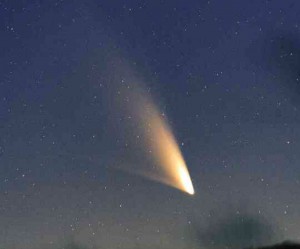Clouds, smog spoil comet’s show in Metro Manila

CELESTIAL SPECTACLE For a fleeting moment, comet Pan-STARRS was visible in Metro Manila at sunset on Sunday despite the clouds and smog. The spectacular photo here was taken from Queenstown, New Zealand. The comet can still be seen in the Philippines in the next few days. AP
MANILA, Philippines—Comet Pan-STARRS was a shade darker than the orange sunset on Manila Bay and it looked like a short fading trail in the twilight.
I thought of making a wish but figured it was a comet, not a falling star. I was rendered speechless by this celestial spectacle.
I’m not sure what to make of the fact the comets fly by so close to Earth, too often. I tried to take a photo but my smartphone could not pick up any decent image because of the distance.
I called my officemates instead but they arrived too late. I was thankful I had a glimpse of the celestial body.
I went to the roof deck of the four-story building of the Inquirer in Makati City at dusk Sunday after reading about the comet in the news.
Astronomers from Pagasa earlier said that the comet should come at sunset and I googled the time it would be visible in Manila.
I doubted if I could catch a glimpse of Pan-STARRS as clouds were threatening to cover the red-orange small opening on the horizon just above the rows of buildings and houses.
I waited for 12 minutes until 6:07 p.m.
Just when I was about to give up and go back to work in the newsroom, I saw a thin reddish streak pass by a cellular phone transmitter downward before it faded. The sight lasted for about 30 seconds as the comet faded into the clouds and smog.
You still have a chance to see a comet for real.
Pan-STARRS is visible in the Northern Hemisphere, including the Philippines.
Shining particularly brightly on March 10, the comet shows up in the western part of the sky just after sunset.
It appears like a stationary star with a tail and will be seen at a relatively low point on the horizon, according to Pagasa (Philippine Atmospheric, Geophysical and Astronomical Services Administration).
The comet has been visible for weeks from the Southern Hemisphere. Now the top half of the world gets a glimpse as well.
California astronomer Tony Phillips said the comet’s proximity to the moon would make it easier for novice sky watchers to find it.
Binoculars likely will be needed for the best viewing, Phillips said, warning onlookers to avoid pointing them at the setting sun.
Weather observer Rex Guerrero of Pagasa’s astronomical observatory said the comet would have been visible to the naked eye some 30 minutes after the sun set. “Unfortunately, here in Metro Manila it could hardly be seen because of the clouds and haze,” he said.
He said people in the provinces may have a better chance if the skies were not cloudy.
The comet was named after the Panoramic Survey Telescope and Rapid Response System which first spotted the heavenly body atop the Haleakala volcano in Hawaii in June 2011.
Thought to be billions of years old, the comet originated in the distant Oort cloud—a cloud of icy bodies well beyond the orbits of Neptune and Pluto—and somehow got propelled toward the inner solar system. It’s never passed by Earth before, Phillips said.—With reports from Jeannette I. Andrade and AP
